Yuqing Liu
How Close Are We? Limitations and Progress of AI Models in Banff Lesion Scoring
Oct 31, 2025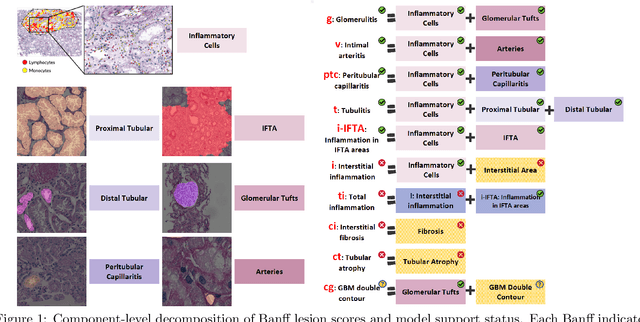

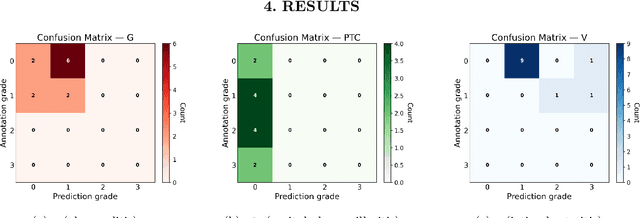
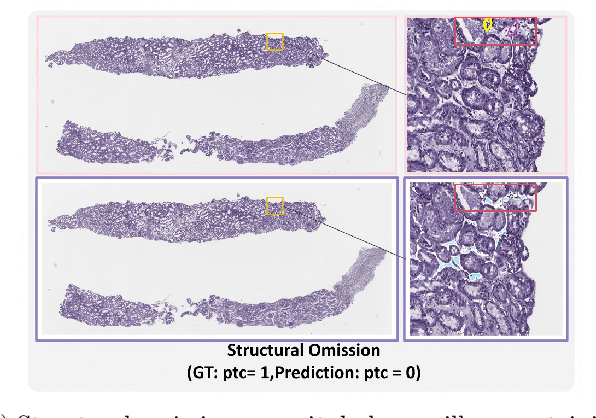
Abstract:The Banff Classification provides the global standard for evaluating renal transplant biopsies, yet its semi-quantitative nature, complex criteria, and inter-observer variability present significant challenges for computational replication. In this study, we explore the feasibility of approximating Banff lesion scores using existing deep learning models through a modular, rule-based framework. We decompose each Banff indicator - such as glomerulitis (g), peritubular capillaritis (ptc), and intimal arteritis (v) - into its constituent structural and inflammatory components, and assess whether current segmentation and detection tools can support their computation. Model outputs are mapped to Banff scores using heuristic rules aligned with expert guidelines, and evaluated against expert-annotated ground truths. Our findings highlight both partial successes and critical failure modes, including structural omission, hallucination, and detection ambiguity. Even when final scores match expert annotations, inconsistencies in intermediate representations often undermine interpretability. These results reveal the limitations of current AI pipelines in replicating computational expert-level grading, and emphasize the importance of modular evaluation and computational Banff grading standard in guiding future model development for transplant pathology.
Cold-Start Recommendation with Knowledge-Guided Retrieval-Augmented Generation
May 27, 2025Abstract:Cold-start items remain a persistent challenge in recommender systems due to their lack of historical user interactions, which collaborative models rely on. While recent zero-shot methods leverage large language models (LLMs) to address this, they often struggle with sparse metadata and hallucinated or incomplete knowledge. We propose ColdRAG, a retrieval-augmented generation approach that builds a domain-specific knowledge graph dynamically to enhance LLM-based recommendation in cold-start scenarios, without requiring task-specific fine-tuning. ColdRAG begins by converting structured item attributes into rich natural-language profiles, from which it extracts entities and relationships to construct a unified knowledge graph capturing item semantics. Given a user's interaction history, it scores edges in the graph using an LLM, retrieves candidate items with supporting evidence, and prompts the LLM to rank them. By enabling multi-hop reasoning over this graph, ColdRAG grounds recommendations in verifiable evidence, reducing hallucinations and strengthening semantic connections. Experiments on three public benchmarks demonstrate that ColdRAG surpasses existing zero-shot baselines in both Recall and NDCG. This framework offers a practical solution to cold-start recommendation by combining knowledge-graph reasoning with retrieval-augmented LLM generation.
Association between nutritional factors, inflammatory biomarkers and cancer types: an analysis of NHANES data using machine learning
Apr 18, 2025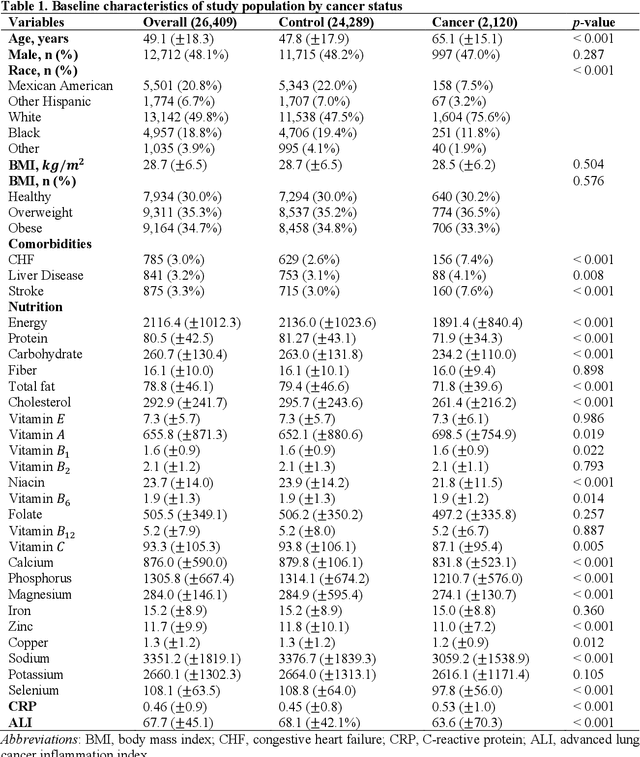
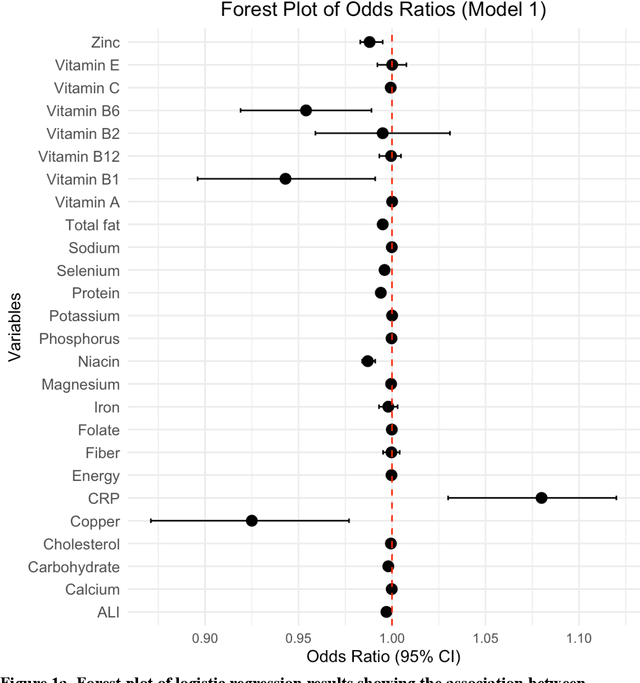
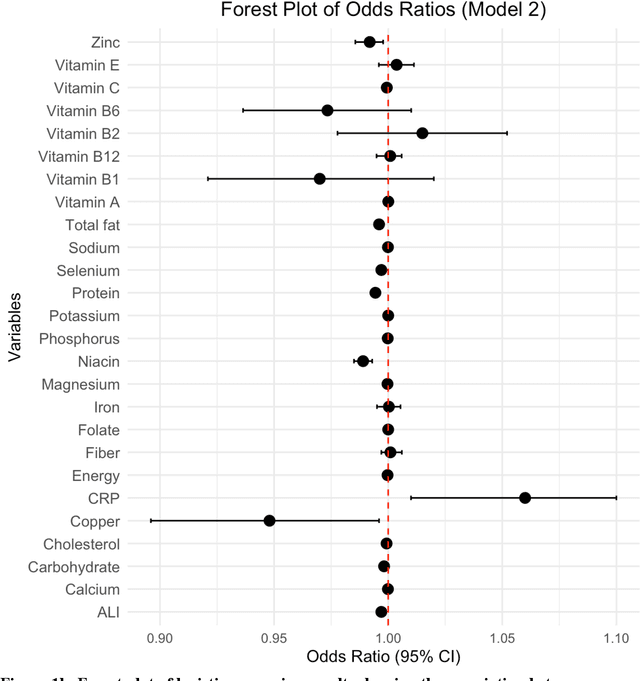

Abstract:Background. Diet and inflammation are critical factors influencing cancer risk. However, the combined impact of nutritional status and inflammatory biomarkers on cancer status and type, using machine learning (ML), remains underexplored. Objectives. This study investigates the association between nutritional factors, inflammatory biomarkers, and cancer status, and whether these relationships differ across cancer types using National Health and Nutrition Examination Survey (NHANES) data. Methods. We analyzed 24 macro- and micronutrients, C-reactive protein (CRP), and the advanced lung cancer inflammation index (ALI) in 26,409 NHANES participants (2,120 with cancer). Multivariable logistic regression assessed associations with cancer prevalence. We also examined whether these features differed across the five most common cancer types. To evaluate predictive value, we applied three ML models - Logistic Regression, Random Forest, and XGBoost - on the full feature set. Results. The cohort's mean age was 49.1 years; 34.7% were obese. Comorbidities such as anemia and liver conditions, along with nutritional factors like protein and several vitamins, were key predictors of cancer status. Among the models, Random Forest performed best, achieving an accuracy of 0.72. Conclusions. Higher-quality nutritional intake and lower levels of inflammation may offer protective effects against cancer. These findings highlight the potential of combining nutritional and inflammatory markers with ML to inform cancer prevention strategies.
LLMInit: A Free Lunch from Large Language Models for Selective Initialization of Recommendation
Mar 03, 2025Abstract:Collaborative filtering models, particularly graph-based approaches, have demonstrated strong performance in capturing user-item interactions for recommendation systems. However, they continue to struggle in cold-start and data-sparse scenarios. The emergence of large language models (LLMs) like GPT and LLaMA presents new possibilities for enhancing recommendation performance, especially in cold-start settings. Despite their promise, LLMs pose challenges related to scalability and efficiency due to their high computational demands and limited ability to model complex user-item relationships effectively. In this work, we introduce a novel perspective on leveraging LLMs for CF model initialization. Through experiments, we uncover an embedding collapse issue when scaling CF models to larger embedding dimensions. To effectively harness large-scale LLM embeddings, we propose innovative selective initialization strategies utilizing random, uniform, and variance-based index sampling. Our comprehensive evaluation on multiple real-world datasets demonstrates significant performance gains across various CF models while maintaining a lower computational cost compared to existing LLM-based recommendation approaches.
Affine Frequency Division Multiplexing: Extending OFDM for Scenario-Flexibility and Resilience
Feb 07, 2025



Abstract:Next-generation wireless networks are conceived to provide reliable and high-data-rate communication services for diverse scenarios, such as vehicle-to-vehicle, unmanned aerial vehicles, and satellite networks. The severe Doppler spreads in the underlying time-varying channels induce destructive inter-carrier interference (ICI) in the extensively adopted orthogonal frequency division multiplexing (OFDM) waveform, leading to severe performance degradation. This calls for a new air interface design that can accommodate the severe delay-Doppler spreads in highly dynamic channels while possessing sufficient flexibility to cater to various applications. This article provides a comprehensive overview of a promising chirp-based waveform named affine frequency division multiplexing (AFDM). It is featured with two tunable parameters and achieves optimal diversity order in doubly dispersive channels (DDC). We study the fundamental principle of AFDM, illustrating its intrinsic suitability for DDC. Based on that, several potential applications of AFDM are explored. Furthermore, the major challenges and the corresponding solutions of AFDM are presented, followed by several future research directions. Finally, we draw some instructive conclusions about AFDM, hoping to provide useful inspiration for its development.
Graph-Sequential Alignment and Uniformity: Toward Enhanced Recommendation Systems
Dec 05, 2024



Abstract:Graph-based and sequential methods are two popular recommendation paradigms, each excelling in its domain but lacking the ability to leverage signals from the other. To address this, we propose a novel method that integrates both approaches for enhanced performance. Our framework uses Graph Neural Network (GNN)-based and sequential recommenders as separate submodules while sharing a unified embedding space optimized jointly. To enable positive knowledge transfer, we design a loss function that enforces alignment and uniformity both within and across submodules. Experiments on three real-world datasets demonstrate that the proposed method significantly outperforms using either approach alone and achieves state-of-the-art results. Our implementations are publicly available at https://github.com/YuweiCao-UIC/GSAU.git.
A DAFT Based Unified Waveform Design Framework for High-Mobility Communications
Jun 04, 2024



Abstract:With the increasing demand for multi-carrier communication in high-mobility scenarios, it is urgent to design new multi-carrier communication waveforms that can resist large delay-Doppler spreads. Various multi-carrier waveforms in the transform domain were proposed for the fast time-varying channels, including orthogonal time frequency space (OTFS), orthogonal chirp division multiplexing (OCDM), and affine frequency division multiplexing (AFDM). Among these, the AFDM is a strong candidate for its low implementation complexity and ability to achieve optimal diversity. This paper unifies the waveforms based on the discrete affine Fourier transform (DAFT) by using the chirp slope factor "k" in the time-frequency representation to construct a unified design framework for high-mobility communications. The design framework is employed to verify that the bit error rate performance of the DAFT-based waveform can be enhanced when the signal-to-noise ratio (SNR) is sufficiently high by adjusting the chirp slope factor "k".
Real-Time 4K Super-Resolution of Compressed AVIF Images. AIS 2024 Challenge Survey
Apr 25, 2024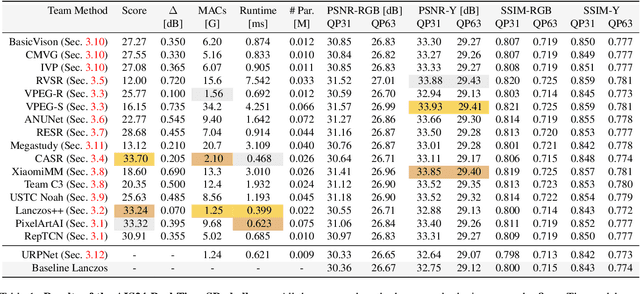

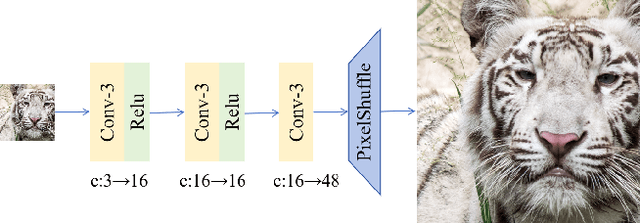
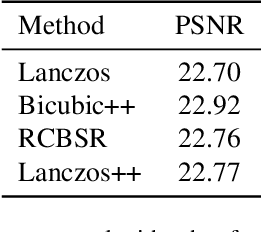
Abstract:This paper introduces a novel benchmark as part of the AIS 2024 Real-Time Image Super-Resolution (RTSR) Challenge, which aims to upscale compressed images from 540p to 4K resolution (4x factor) in real-time on commercial GPUs. For this, we use a diverse test set containing a variety of 4K images ranging from digital art to gaming and photography. The images are compressed using the modern AVIF codec, instead of JPEG. All the proposed methods improve PSNR fidelity over Lanczos interpolation, and process images under 10ms. Out of the 160 participants, 25 teams submitted their code and models. The solutions present novel designs tailored for memory-efficiency and runtime on edge devices. This survey describes the best solutions for real-time SR of compressed high-resolution images.
The Ninth NTIRE 2024 Efficient Super-Resolution Challenge Report
Apr 16, 2024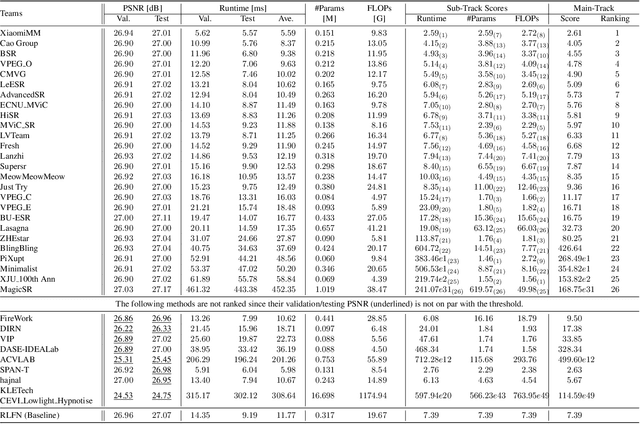
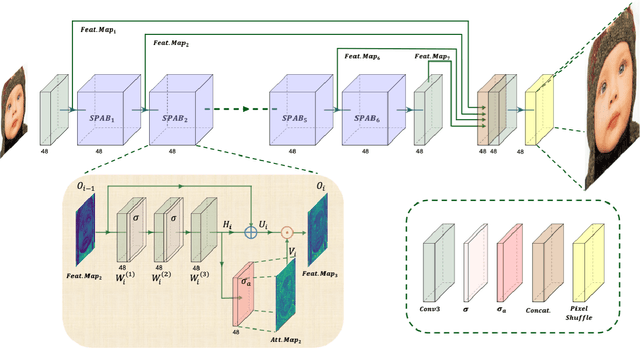


Abstract:This paper provides a comprehensive review of the NTIRE 2024 challenge, focusing on efficient single-image super-resolution (ESR) solutions and their outcomes. The task of this challenge is to super-resolve an input image with a magnification factor of x4 based on pairs of low and corresponding high-resolution images. The primary objective is to develop networks that optimize various aspects such as runtime, parameters, and FLOPs, while still maintaining a peak signal-to-noise ratio (PSNR) of approximately 26.90 dB on the DIV2K_LSDIR_valid dataset and 26.99 dB on the DIV2K_LSDIR_test dataset. In addition, this challenge has 4 tracks including the main track (overall performance), sub-track 1 (runtime), sub-track 2 (FLOPs), and sub-track 3 (parameters). In the main track, all three metrics (ie runtime, FLOPs, and parameter count) were considered. The ranking of the main track is calculated based on a weighted sum-up of the scores of all other sub-tracks. In sub-track 1, the practical runtime performance of the submissions was evaluated, and the corresponding score was used to determine the ranking. In sub-track 2, the number of FLOPs was considered. The score calculated based on the corresponding FLOPs was used to determine the ranking. In sub-track 3, the number of parameters was considered. The score calculated based on the corresponding parameters was used to determine the ranking. RLFN is set as the baseline for efficiency measurement. The challenge had 262 registered participants, and 34 teams made valid submissions. They gauge the state-of-the-art in efficient single-image super-resolution. To facilitate the reproducibility of the challenge and enable other researchers to build upon these findings, the code and the pre-trained model of validated solutions are made publicly available at https://github.com/Amazingren/NTIRE2024_ESR/.
Uncertainty in Graph Neural Networks: A Survey
Mar 11, 2024



Abstract:Graph Neural Networks (GNNs) have been extensively used in various real-world applications. However, the predictive uncertainty of GNNs stemming from diverse sources such as inherent randomness in data and model training errors can lead to unstable and erroneous predictions. Therefore, identifying, quantifying, and utilizing uncertainty are essential to enhance the performance of the model for the downstream tasks as well as the reliability of the GNN predictions. This survey aims to provide a comprehensive overview of the GNNs from the perspective of uncertainty with an emphasis on its integration in graph learning. We compare and summarize existing graph uncertainty theory and methods, alongside the corresponding downstream tasks. Thereby, we bridge the gap between theory and practice, meanwhile connecting different GNN communities. Moreover, our work provides valuable insights into promising directions in this field.
 Add to Chrome
Add to Chrome Add to Firefox
Add to Firefox Add to Edge
Add to Edge